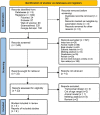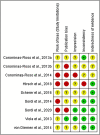Peripheral neurotrophin levels during controlled crack/cocaine abstinence: a systematic review and meta-analysis
- PMID: 38228745
- PMCID: PMC10791690
- DOI: 10.1038/s41598-024-51901-2
Peripheral neurotrophin levels during controlled crack/cocaine abstinence: a systematic review and meta-analysis
Abstract
Cocaine/crack abstinence periods have higher risk of relapse. Abstinence as initial part of the recovery process is affected by learning and memory changes that could preserve the addictive cycle. To further understand how the interruption of cocaine/crack consumption affects neurotrophin level we performed the present systematic review and meta-analysis following the PRISMA statement (number CRD42019121643). The search formula was conducted in PubMed, Web of Science, Embase, ScienceDirect, and Google Scholar databases. The inclusion criterion was cocaine use disorder in 18 to 60-year-old people, measuring at least one neurotrophin in blood before and after a controlled abstinence period. Studies without pre-post design were excluded. Five investigations had nine different reports, four of them were subjected to a meta-analysis (n = 146). GRADE risk of bias method was followed. Individual studies reported increased peripheral brain derived neurotrophic factor (BDNF) after abstinence, evidence pooled by Hedge's g showed no significant change in BDNF after abstinence. Relevant heterogeneity in the length of the abstinence period (12-32 days), last cocaine/crack consumption monitoring and blood processing were detected that could help to explain non-significant results. Further improved methods are suggested, and a potential BDNF augmentation hypothesis is proposed that, if true, would help to understand initial abstinence as a re-adaptation period influenced by neurotrophins such as the BDNF.
© 2024. The Author(s).
Conflict of interest statement
The authors declare no competing interests.
Figures



References
-
- 2023 World drug report: Key Messages. 10.18356/9789210028233c001 (2023)
-
- American Psychiatric Association Diagnostic and statistical manual of mental disorders: DSM-5. Am. Psychiatr. Assoc. 2013 doi: 10.1176/appi.books.9780890425596.744053. - DOI
-
- SAHMSA. Key Substance Use and Mental Health Indicators in the United States: Results from the 2021 National Survey on Drug Use and Health. HHS Publication No. PEP19–5068, NSDUH Series H-54 (2022).
Publication types
MeSH terms
Substances
LinkOut - more resources
Full Text Sources
Medical

